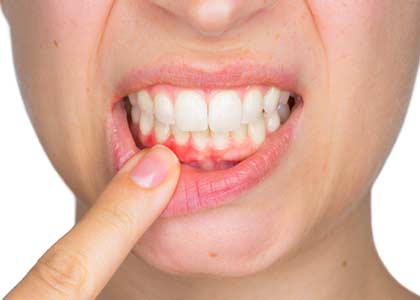Gum disease is a common problem that affects millions of people. A potentially serious condition, gum disease begins as swelling in the gum tissue surrounding teeth. For many, only a few teeth are affected, though untreated gum disease will likely spread from tooth to tooth.
Gum Disease

The 3 stages of gum disease are gingivitis, periodontitis, and advanced periodontitis. Gingivitis is caused by toxins irritating the gum line as a result of plaque buildup. Signs and symptoms of gingivitis can include swelling, sensitivity and bleeding of the gums during brushing and flossing. Gingivitis can be easily reversed through professional care and good home oral hygiene. Periodontitis is categorized as irreversible bone loss that results from untreated gingivitis. The Gums may begin to form a pocket below the gum line which traps food and plaque. Dental treatment and home care can help prevent from further damage but at this stage the results are not reversible. Advanced Periodontitis is when the fiber and bones supporting the teeth are destroyed. This may cause teeth to shift or loosen; teeth may have to be removed depending on how advance the disease has become and if treatment are non-effective. You can begin by preventing gum disease with good oral health. Pick up a brochure or ask your dentist today
The condition develops because of toxic bacterial waste, from bacteria
in plaque, which causes the inflammation in gum tissue. Plaque can be
removed with twice a day brushing and regular six-month cleanings with
our experienced hygienist. When not properly removed, plaque will build
up around teeth, and can harden into tartar. Bacteria flourish in plaque
and tartar, weakening both teeth and gum tissue.
Gum tissue is an important
part of our oral structure. This soft tissue supports teeth in their
proper positions, and keeps them stable for chewing. When affected by
gum disease, the gums and bone cannot adequately support teeth, which
can become loose, or even fall out in the case of advanced periodontal
disease. The early signs of gum disease can be easy to miss without
professional evaluation. At Washington Street Dentistry, we carefully
examine gum tissue as a part of our routine dental checkups, giving us
the chance to treat gum disease early.
Stages of Gum Disease
Gum disease is progressive, which points to the importance of early treatment. In its earliest form, gingivitis,
gum disease can be reversed. However, this is the hardest time to spot
the signs. One clue to watch for is bleeding gums. When you brush and
floss your teeth, even if you do so aggressively, gums should not bleed.
If they do, you should seek treatment to return to optimal oral health.
Untreated, gingivitis can progress to periodontitis,
in which plaque has reached the roots of teeth, causing infection below
the gums. Periodontitis can and should be treated so that supportive
fibers and bone tissue do not sustain damage.
Advanced periodontal
disease can cause teeth to become loose, even shifting in position and
affecting the bite. When gum disease has progressed to this extent, the
bone and supporting fibers might sustain extensive damage that could
lead to the loss of teeth.
The team at Washington
Street Dentistry has the training to diagnose and treat gum disease
properly so that your smile remains healthy and attractive. Our
hygienists provide personalized care for each stage of gum disease, and
can guide you on ideal home hygiene techniques for the promotion of
healthy gums.
Contact us in Indianapolis for your gum disease evaluation.
Related Video
Understanding Gum Disease









